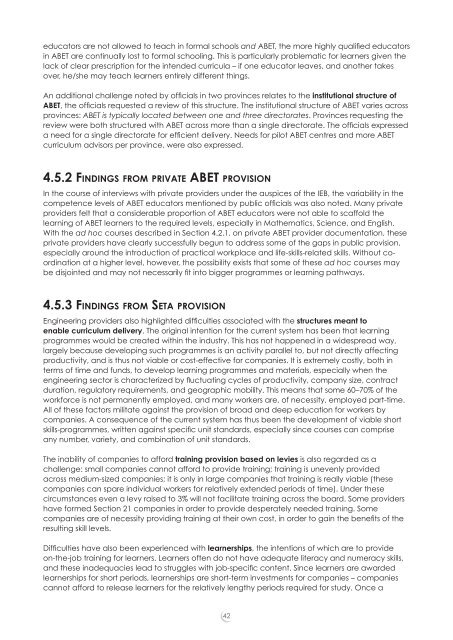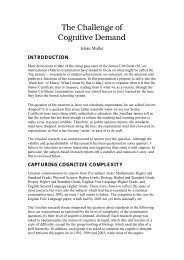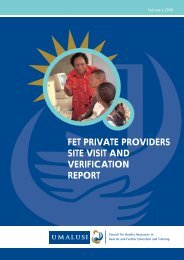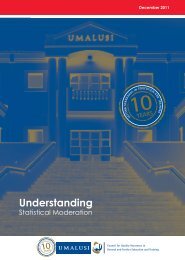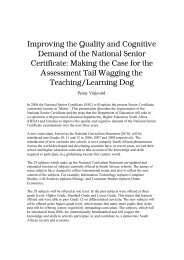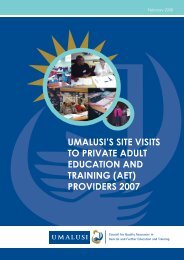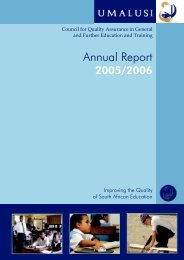Inspecting the Foundations - Umalusi
Inspecting the Foundations - Umalusi
Inspecting the Foundations - Umalusi
You also want an ePaper? Increase the reach of your titles
YUMPU automatically turns print PDFs into web optimized ePapers that Google loves.
educators are not allowed to teach in formal schools and ABET, <strong>the</strong> more highly qualifi ed educatorsin ABET are continually lost to formal schooling. This is particularly problematic for learners given <strong>the</strong>lack of clear prescription for <strong>the</strong> intended curricula – if one educator leaves, and ano<strong>the</strong>r takesover, he/she may teach learners entirely different things.An additional challenge noted by offi cials in two provinces relates to <strong>the</strong> institutional structure ofABET, <strong>the</strong> offi cials requested a review of this structure. The institutional structure of ABET varies acrossprovinces: ABET is typically located between one and three directorates. Provinces requesting <strong>the</strong>review were both structured with ABET across more than a single directorate. The offi cials expresseda need for a single directorate for effi cient delivery. Needs for pilot ABET centres and more ABETcurriculum advisors per province, were also expressed.4.5.2 FINDINGS FROM PRIVATE ABET PROVISIONIn <strong>the</strong> course of interviews with private providers under <strong>the</strong> auspices of <strong>the</strong> IEB, <strong>the</strong> variability in <strong>the</strong>competence levels of ABET educators mentioned by public offi cials was also noted. Many privateproviders felt that a considerable proportion of ABET educators were not able to scaffold <strong>the</strong>learning of ABET learners to <strong>the</strong> required levels, especially in Ma<strong>the</strong>matics, Science, and English.With <strong>the</strong> ad hoc courses described in Section 4.2.1. on private ABET provider documentation, <strong>the</strong>seprivate providers have clearly successfully begun to address some of <strong>the</strong> gaps in public provision,especially around <strong>the</strong> introduction of practical workplace and life-skills-related skills. Without coordinationat a higher level, however, <strong>the</strong> possibility exists that some of <strong>the</strong>se ad hoc courses maybe disjointed and may not necessarily fi t into bigger programmes or learning pathways.4.5.3 FINDINGS FROM SETA PROVISIONEngineering providers also highlighted diffi culties associated with <strong>the</strong> structures meant toenable curriculum delivery. The original intention for <strong>the</strong> current system has been that learningprogrammes would be created within <strong>the</strong> industry. This has not happened in a widespread way,largely because developing such programmes is an activity parallel to, but not directly affectingproductivity, and is thus not viable or cost-effective for companies. It is extremely costly, both interms of time and funds, to develop learning programmes and materials, especially when <strong>the</strong>engineering sector is characterized by fl uctuating cycles of productivity, company size, contractduration, regulatory requirements, and geographic mobility. This means that some 60–70% of <strong>the</strong>workforce is not permanently employed, and many workers are, of necessity, employed part-time.All of <strong>the</strong>se factors militate against <strong>the</strong> provision of broad and deep education for workers bycompanies. A consequence of <strong>the</strong> current system has thus been <strong>the</strong> development of viable shortskills-programmes, written against specifi c unit standards, especially since courses can compriseany number, variety, and combination of unit standards.The inability of companies to afford training provision based on levies is also regarded as achallenge: small companies cannot afford to provide training; training is unevenly providedacross medium-sized companies; it is only in large companies that training is really viable (<strong>the</strong>secompanies can spare individual workers for relatively extended periods of time). Under <strong>the</strong>secircumstances even a levy raised to 3% will not facilitate training across <strong>the</strong> board. Some providershave formed Section 21 companies in order to provide desperately needed training. Somecompanies are of necessity providing training at <strong>the</strong>ir own cost, in order to gain <strong>the</strong> benefi ts of <strong>the</strong>resulting skill levels.Diffi culties have also been experienced with learnerships, <strong>the</strong> intentions of which are to provideon-<strong>the</strong>-job training for learners. Learners often do not have adequate literacy and numeracy skills,and <strong>the</strong>se inadequacies lead to struggles with job-specifi c content. Since learners are awardedlearnerships for short periods, learnerships are short-term investments for companies – companiescannot afford to release learners for <strong>the</strong> relatively lengthy periods required for study. Once a42


